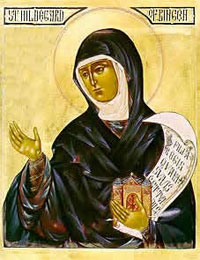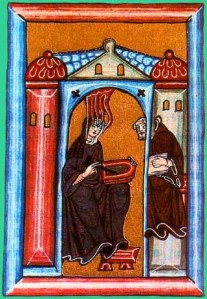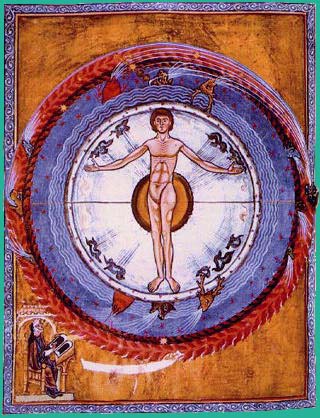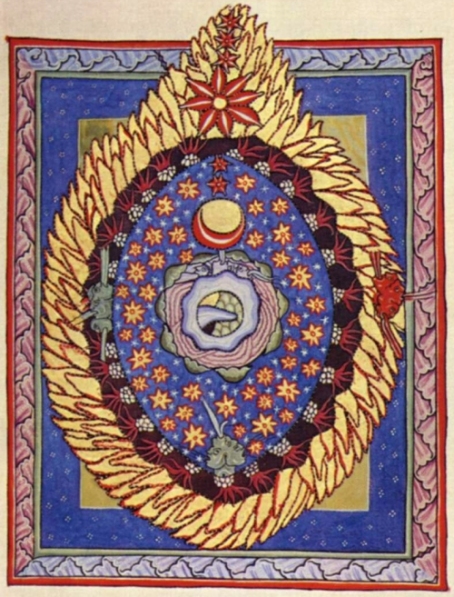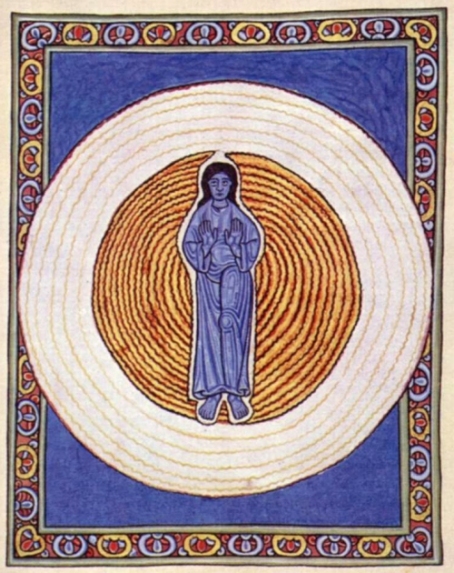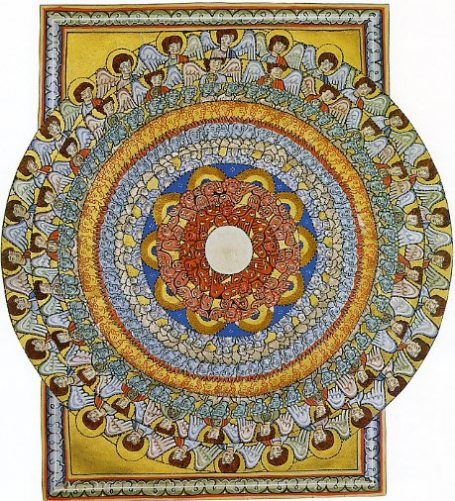Mondala Monday – Monastic Mandalas: Hildegard of Bingen by Lillian Sizemore
As a lover of Early Music, I have been familiar with Hildegard of Bingen’s chants for many years, but I had no idea she (or anyone else in the western world) created mandalas in the Middle Ages. Not being a historian of art I assumed the form came from the east (Tibet, India) and was delighted to see this article about Monastic Mandalas. I’m also delighted that Lillain Sizemore was gracious enough to allow me to reprint her blog post here. Thank you Lillian, for allowing me to share this with my readers.
—————————————————————————————————————————
As a child, I often saw or felt ‘entities’ from other worlds. Many children report supersensory experiences and one such child was Hildegard von Bingen.
Hildegard of Bingen, (1098-1179) was born a tenth child to a German noble family. She was an influential and spiritual woman whose fierce devotion paved the way for future generations of women to succeed in fields from theology, to medicine, to music and art. At a very early age she claimed to experience supernatural visions of a powerful, transformative light, but she hid her prophetic abilities until much later in life. She was admitted into a convent at the age of eight, and was prepared for a life of hermetic devotion and meditation.
Although Hildegard was not formally educated, her desire to record her visions and messages into book form was undeterred. She relied on secretaries to help transcribe her ideas onto paper and was a prolific writer on topics of philosophy, herbal medicine, the natural world, and a noted composer of hauntingly beautiful chants.
Hildegard became a well-regarded authority and the Mother Superior of her convent. Around 1135, at age 42, she undertook a series of visionary symbolic paintings in unmistakable mandala-forms. While she did not make the illustrations herself, it is thought that she oversaw their production. These cosmic memories occur in myth and archtypes we readily recognize. The pictures were thought to be as strong or stronger than the words themselves. There is a gesltalt immediacy, what Hindu’s refer to as darshan, meaning the simultaneous act of seeing and being seen by a deity.
Universal Man. Manuscript illumination from
Liber divinorum operum or De operatione dei
(Book of Divine Works) by Hildegard of Bingen,
1163–74. Biblioteca Statale, Lucca
She created a drawing, or illumination, in her manuscript Scivias (Know the Ways), circa 1140–50, of her defining vision, in which the great span of the universe revealed itself to her in a trance as “round and shadowy…pointed at the top, like an egg…its outermost layer of a bright fire.”
Das Weltall. Manuscript illumination from Scivias
(Know the Ways) by Hildegard of Bingen (Disibodenberg: 1151)
Die wahre Dreiheit in der wahren Einheit.
Manuscript illumination from Scivias (Know the Ways)
by Hildegard of Bingen (Disibodenberg: 1151)
Hildegard’s visions led her to channel cosmic laws into illuminations and illustrate invisible concepts such as ethers, air, and wind. She assigns meaning to these elements to represent such virtues as atonement, righteousness, and moderation.
Cultivating the Cosmic Tree
Central to her mandala paintings is the understanding of a ‘cosmic equilibrium’ and a reverence for all life. In her use of ‘quartering of the circle’ we recognize the four elements (fire, air, water and earth), an archetypal depiction also used by Native American sand painters for the four sacred directions. Her concept of Viriditas, the Greening, was a precursor to our ecology movement. She described this power as the agent of the God, a divine vitality, that was the animating life-force within all creation. This ‘Greenness’ was the very expression of Divine Power on Earth.
All Beings Celebrate Creation
As Stephanie Roth explains in her article The Cosmic Visions of Hildegard of Bingen:
Since this extraordinary phenomenon called life could only be created by God,
Hildegard believed, all that lives equally carried his Divine energy,
or ‘viritas’ [sic]. In her own words:
Oh fire of the Holy Spirit,
life of the life of every creature,
holy are you in giving life to forms…
Oh boldest path,
penetrating into all places,
in the heights, on earth,
and in every abyss,
you bring and bind all together
From you clouds flow, air flies,
Rocks have their humours,
Rivers spring forth from the waters
And earth wears her green vigour
O ignis Spiritus Paracliti
This is the foundation upon which all her texts rest, whether songs, visions or natural observations.
In a time when women were not allowed self-expression, Hildegard used art for very specific communicative purposes.Though she did not use traditional reasoning to arrive at her realizations, she presents us with subjective experience of the heart, through art, poetry, and music. Her work allows us to interpret and mold the ideas to our own personal experience and situation. This is not unlike the direct experience one can have with the illuminations in the recently published tome of C. G. Jung, the Red Book: Liber Novus.
There is a wealth of academic research available, and a growing curiosity and acceptance of her works. Perhaps now is the time for Hildegard’s fifteen minutes of fame? Just released, is a gorgeous, new German-language film “Vision” by Margarethe von Trotta.
Article © Lillian Sizemore, http://www.sfmosaic.wordpress.com
Bio:
Lillian Sizemore is a professional artist, educator, and independent scholar. She creates mandalas and observes pattern and geometry to connect to a deeper vibration of harmony and universal wholeness. Her mosaic work is featured in Mosaic Techniques and Traditions and Mosaic Art and Style. Lillian has traveled widely, documenting mosaic sites around the world. She authored A Guide to Mosaic Sites: San Francisco (http://www.sfmosaic.com/guidebook/index.php), a walker’s guide to publicly accessible mosaic sites, as well as many articles and book reviews. She is an invited artist-lecturer at the Getty Vila and on the faculty at the Institute of Mosaic Art.
http://www.sfmosaic.wordpress.com
http://www.sfmosaic.com
http://twitter.com/Musiva
———————————————————————————————————
I look forward to your thoughts and comments!
Be sure to Subscribe to this blog either by RSS or Email via the forms on the top right column of the page.

